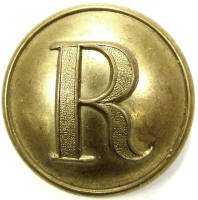
A virtual examination of artifacts of the American Civil War
 |
Ridgeway Civil War Research Center, A virtual examination of artifacts of the American Civil War |
| Civil War Artillery | |
| by Harry Ridgeway |
| Rifled artillery projectile, James design, Federal manufacture, bursting shell, "common" (standard), closed base with slots, lead and tin sleeve sabot, James percussion fuze, James 14 pounder rifle, 3.8in. Projectile was manufactured in the Federal arsenals following the invention of Charles James. The earlier hollow caged cavity was replaced with a flanged base with tapered tail, covered by a thick lead sabot, referred to as Type II. This eliminated the automatic blowout of the sabot from the hollow cavity design, but left a very heavy sabot that tended to significantly distort on firing, consequently this pattern was not particularly successful either. Shell is common shot (does not contain balls) and with percussion fuze was designed to be used against opposing cannon by striking the equipment . Fuze employed was the James brass anvil percussion fuze, "West Point" two part fuze , Jones pg. 30 . Projectile measures: diameter 3.7in., length 7.5in. weight 14lbs , with sabot. Research Center: Artillery4426-James, Ref: Dickey & George, Field Artillery (1993 Edition), pg. 190. Details click: http://relicman.com/artillery/Artillery4426-James.html. |
| Ridgeway Civil War Research Center, A virtual examination of artifacts of the American Civil War. Artillery Research center, artillery, click: http://relicman.com/artillery/Artillery0000-Index.html. Research center, artillery, click: http://relicman.com/artillery/Artillery0000-Index.html. |
| Civil War Relicman, Harry Ridgeway, Civil War artillery, Relicman sales catalog. Click here: http://relicman.com/artillery/RelicmanSalesArtillery1.html. Artillery for sale: http://relicman.com/artillery/RelicmanSalesArtillery1.html. |